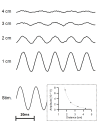Determination of object position, vortex shedding frequency and flow velocity using artificial lateral line canals
- PMID: 21977440
- PMCID: PMC3148032
- DOI: 10.3762/bjnano.2.32
Determination of object position, vortex shedding frequency and flow velocity using artificial lateral line canals
Abstract
The lateral line system of fish consists of superficial neuromasts, and neuromasts embedded in lateral line canals. Lateral line neuromasts allow fish to sense both minute water motions and pressure gradients, thereby enabling them to detect predators and prey or to recognize and discriminate stationary objects while passing them. With the aid of the lateral line, fish can also sense vortices caused by an upstream object or by undulatory swimming movements of fish. We show here that artificial lateral line canals equipped with optical flow sensors can be used to detect the water motions generated by a stationary vibrating sphere, the vortices caused by an upstream cylinder or the water (air) movements caused by a passing object. The hydrodynamic information retrieved from optical flow sensors can be used to calculate bulk flow velocity and thus the size of the cylinder that shed the vortices. Even a bilateral sensor platform equipped with only one artificial lateral line canal on each side is sufficient to determine the position of an upstream cylinder.
Keywords: artificial lateral line; biomimetics; flow sensor; mechanoreception; optical sensor.
Figures








Similar articles
-
Distributed flow estimation and closed-loop control of an underwater vehicle with a multi-modal artificial lateral line.Bioinspir Biomim. 2015 Mar 25;10(2):025002. doi: 10.1088/1748-3190/10/2/025002. Bioinspir Biomim. 2015. PMID: 25807584
-
Hydrodynamic pressure sensing with an artificial lateral line in steady and unsteady flows.Bioinspir Biomim. 2012 Sep;7(3):036004. doi: 10.1088/1748-3182/7/3/036004. Epub 2012 Apr 12. Bioinspir Biomim. 2012. PMID: 22498729
-
Responses of medullary lateral line units of the rudd, Scardinius erythrophthalmus, and the nase, Chondrostoma nasus, to vortex streets.J Comp Physiol A Neuroethol Sens Neural Behav Physiol. 2018 Feb;204(2):155-166. doi: 10.1007/s00359-017-1217-1. Epub 2017 Oct 26. J Comp Physiol A Neuroethol Sens Neural Behav Physiol. 2018. PMID: 29075852
-
Lateral line system of fish.Integr Zool. 2009 Mar;4(1):13-25. doi: 10.1111/j.1749-4877.2008.00131.x. Integr Zool. 2009. PMID: 21392273 Review.
-
Flow field perception based on the fish lateral line system.Bioinspir Biomim. 2019 May 3;14(4):041001. doi: 10.1088/1748-3190/ab1a8d. Bioinspir Biomim. 2019. PMID: 30995633 Review.
Cited by
-
Head width influences flow sensing by the lateral line canal system in fishes.J Exp Biol. 2018 Oct 29;221(Pt 21):jeb180877. doi: 10.1242/jeb.180877. J Exp Biol. 2018. PMID: 30194249 Free PMC article.
-
Medullary lateral line units of rudd, Scardinius erythrophthalmus, are sensitive to Kármán vortex streets.J Comp Physiol A Neuroethol Sens Neural Behav Physiol. 2015 Jul;201(7):691-703. doi: 10.1007/s00359-015-1016-5. Epub 2015 May 28. J Comp Physiol A Neuroethol Sens Neural Behav Physiol. 2015. PMID: 26018072
-
A fish perspective: detecting flow features while moving using an artificial lateral line in steady and unsteady flow.J R Soc Interface. 2014 Oct 6;11(99):20140467. doi: 10.1098/rsif.2014.0467. J R Soc Interface. 2014. PMID: 25079867 Free PMC article.
-
Nanofibril scaffold assisted MEMS artificial hydrogel neuromasts for enhanced sensitivity flow sensing.Sci Rep. 2016 Jan 14;6:19336. doi: 10.1038/srep19336. Sci Rep. 2016. PMID: 26763299 Free PMC article.
-
Cupula-Inspired Hyaluronic Acid-Based Hydrogel Encapsulation to Form Biomimetic MEMS Flow Sensors.Sensors (Basel). 2017 Jul 28;17(8):1728. doi: 10.3390/s17081728. Sensors (Basel). 2017. PMID: 28788059 Free PMC article.
References
-
- Bender M, Gnatzy W, Tautz J. J Comp Physiol, A. 1984;154:45–47. doi: 10.1007/BF00605388. - DOI
-
- Humphrey J, Barth F. Medium Flow-Sensing Hairs: Biomechanics and Models. In: Casas J, Simpson S J, editors. Advances in Insect Physiology. Vol. 34. New York: Academic Press; 2007. pp. 1–80.
-
- Shimozawa T, Murakami J, Kumagai T. Cricket wind receptors: thermal noise for the highest sensitivity known. In: Barth F, Humphrey J, Secomb T, editors. Sensors and Sensing in Biology and Engineering. Springer; 2003. pp. 145–158.
-
- Bleckmann H. J Comp Physiol, A. 1980;140:163–172. doi: 10.1007/BF00606308. - DOI
LinkOut - more resources
Full Text Sources
